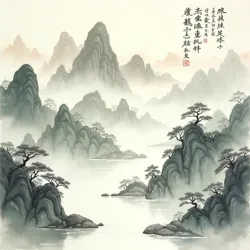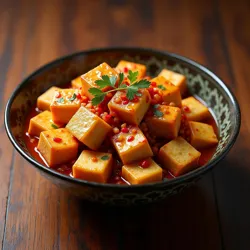Shuhanese Culture

Depicted is the rich tapestry of Shuhanese culture, known as the 'Culture of the Brocade Rivers', showcasing refined arts, leisurely life, distinctive cuisine, and natural beauty in the Sichuan Basin of the Jade Lands.
Sichuan Basin, Jade Lands
Culture of the Brocade Rivers
Sichuan cuisine
leisure and refinement
Concordian Way
Shuhanese culture (蜀漢文化, Shǔhàn Wénhuà) embodies the unique traditions, customs, arts, and societal norms that have developed within the kingdom of Shu-Han, nestled in the fertile Sichuan Basin of the Jade Lands. Often referred to as the 'Culture of the Brocade Rivers' (錦江文化, Jǐnjiāng Wénhuà), Shuhanese culture is distinguished by its refined artistic sensibilities, a leisurely pace of life, a celebrated and distinctive cuisine, and a deep-rooted appreciation for natural beauty. Centuries of relative geographical isolation, combined with the rich resources of the Sichuan Basin, have fostered a civilization that is both introspective and creatively vibrant, setting it apart within the diverse cultural mosaic of the Jade Lands.
Origins and Influences
The genesis of Shuhanese culture can be traced back to the ancient state of Shu, which flourished in the Sichuan Basin long before the fragmentation of the Tang Dynasty and the subsequent Ten Kingdoms Era. This ancient Shu heritage provides a foundational layer to Shuhanese Identity, imbuing it with a sense of historical depth and continuity. Archaeological discoveries within the basin reveal a sophisticated Bronze Age culture, with unique artistic styles and ritual practices that predate broader Jade Lands cultural trends.
The Concordian Way, the dominant spiritual and philosophical tradition of the Jade Lands, has profoundly shaped Shuhanese values and societal structures. While embracing the core tenets of harmonious concord, ancestral veneration, and moral cultivation, Shuhanese interpretations of the Concordian Way often emphasize aesthetic expression and a contemplative approach to life, aligning with the kingdom's artistic and leisurely ethos. The Mount Hua Holy See, the central religious authority of the Concordian Way, is respected in Shu-Han, but local adaptations and syncretic beliefs also play a significant role in the kingdom's spiritual landscape.
Geographical factors have exerted a considerable influence on the development of Shuhanese culture. The Sichuan Basin, enclosed by mountain ranges, provided both protection and a degree of isolation. This natural barrier limited external military pressures, allowing Shuhanese culture to evolve relatively undisturbed. The basin's fertile lands and abundant resources fostered economic self-sufficiency, enabling the society to focus on cultural pursuits and internal development rather than constant warfare or expansion. The Jing River and its tributaries, the 'Brocade Rivers' themselves, have been vital arteries for transportation, agriculture, and inspiration, deeply embedded in Shuhanese artistic and literary expressions.
Society and Values
Shuhanese society is characterized by a relatively relaxed and harmonious social fabric. While a traditional hierarchical structure exists, with scholars and officials historically at the apex, followed by landowners, merchants, and farmers, social mobility has been comparatively more fluid than in some other Jade Lands states. Education, artistic talent, and entrepreneurial acumen have all served as pathways for upward social movement.
Emphasis on Leisure and Refinement: A defining characteristic of Shuhanese society is its appreciation for leisure and the refined aspects of life. Unlike the more commercially driven or militarily focused cultures of Jing-Hua or Liang-Ning, Shuhanese culture values savoring the present moment, engaging in artistic pursuits, and cultivating personal well-being. Tea houses, gardens, and public parks are integral to Shuhanese social life, serving as spaces for relaxation, social interaction, and cultural exchange.
Hospitality and Community: Hospitality is deeply ingrained in Shuhanese social etiquette. Generosity towards guests and strangers alike is highly valued, reflecting a strong sense of community and social interconnectedness. Festivals, communal celebrations, and family gatherings play a crucial role in reinforcing social bonds and transmitting cultural values across generations. The concept of renqing (人情, rénqíng), emphasizing reciprocal social obligations and the maintenance of harmonious relationships, is central to Shuhanese social interactions.
Respect for Education and Arts: Learning and artistic achievement are highly esteemed in Shuhanese society. Scholars and artists have traditionally enjoyed considerable social prestige, and patronage of the arts has been a long-standing tradition among the ruling elite and wealthy merchant classes. Calligraphy, painting, poetry, and music are not merely considered aesthetic pursuits but also pathways to moral cultivation and social refinement. The pursuit of knowledge and artistic expression is seen as contributing to both individual and societal betterment.
Pragmatic Approach to Life: Despite the emphasis on leisure and artistic refinement, Shuhanese society also exhibits a pragmatic and resourceful approach to daily life. Centuries of navigating a geographically enclosed basin have fostered a culture of self-reliance and adaptability. Shuhanese ingenuity is evident in their sophisticated agricultural techniques, their thriving craft industries, and their culinary innovations. This pragmatism is often tempered by a characteristic Shuhanese sense of humor and a down-to-earth perspective, preventing societal values from becoming overly rigid or detached from practical realities.
Arts and Aesthetics
Shuhanese artistic traditions are renowned throughout the Jade Lands for their delicate beauty, emotional expressiveness, and technical mastery. Often drawing inspiration from the natural landscapes of the Sichuan Basin, Shuhanese art forms are characterized by a harmonious balance between meticulous detail and evocative atmosphere.
 Shown is a Shuhanese ink wash painting, featuring misty mountains and tranquil rivers, exemplifying the delicate beauty and emotional expressiveness of Shuhanese art, drawing inspiration from the Sichuan Basin landscapes.
Shown is a Shuhanese ink wash painting, featuring misty mountains and tranquil rivers, exemplifying the delicate beauty and emotional expressiveness of Shuhanese art, drawing inspiration from the Sichuan Basin landscapes.Painting and Calligraphy: Shuhanese painting is celebrated for its distinctive style, often featuring misty mountainscapes, tranquil river scenes, and lush depictions of flora and fauna. Ink wash painting (shuǐmòhuà, 水墨畫) is a particularly prominent form, characterized by subtle gradations of ink tone and expressive brushstrokes. Color is often used sparingly, emphasizing the ethereal and atmospheric qualities of the Sichuan landscape. Calligraphy, closely intertwined with painting, is also highly esteemed. Shuhanese calligraphers are known for their elegant and flowing scripts, often imbued with personal expression and emotional resonance.
Silk Brocade Weaving: Shu-Han has been a center of silk production and brocade weaving for centuries. Shuhanese silk brocades are prized for their intricate patterns, vibrant colors, and exquisite craftsmanship. Traditional motifs often incorporate auspicious symbols, floral designs, and scenes from nature or folklore. The 'Brocade Rivers' themselves are symbolically represented in many silk patterns, reflecting the close connection between the kingdom and its waterways. Shuhanese silk brocades are not only used for clothing and textiles but also as artistic tapestries and decorative panels.
Ceramics and Lacquerware: Shuhanese ceramics are known for their refined forms, delicate glazes, and subtle decorative motifs. Celadon ware, with its characteristic jade-green glaze, is a particularly celebrated ceramic tradition in Shu-Han. Lacquerware, another highly developed craft, involves applying multiple layers of lacquer to wooden or bamboo objects, often adorned with intricate carvings or inlaid designs. Shuhanese lacquerware is prized for its durability, lustrous finish, and artistic embellishments.
Poetry and Literature: Shuhanese literature, particularly poetry, is rich and diverse, reflecting the kingdom's cultural values and aesthetic sensibilities. Shuhanese poets are known for their lyrical descriptions of nature, their introspective explorations of human emotions, and their use of vivid imagery and evocative language. Themes of nature, love, friendship, and the beauty of everyday life are frequently explored in Shuhanese poetry. Shuhanese opera (川劇, Chuānjù), a distinct regional form of opera, is also a significant artistic expression, combining music, drama, dance, and acrobatics to tell stories from history, folklore, and popular narratives.
Music and Performing Arts: Music plays a vital role in Shuhanese cultural life. Traditional Shuhanese music encompasses a variety of genres, including folk songs, instrumental pieces, and operatic forms. Stringed instruments such as the guzheng (古箏) and pipa (琵琶), as well as wind instruments like the dizi (笛子) and suona (唢呐), are commonly used. Performing arts, including opera, dance, and storytelling, are popular forms of entertainment and cultural expression, often performed during festivals and community gatherings.
Cuisine and Culinary Traditions
Shuhanese cuisine, globally recognized as Sichuan cuisine, is arguably the most famous and influential aspect of Shuhanese culture. Renowned for its bold and complex flavors, Sichuan cuisine is characterized by the liberal use of chili peppers, Sichuan peppercorns (huājiāo, 花椒), garlic, and fermented sauces. The cuisine is not merely about spiciness but also about a nuanced interplay of flavors, including savory, sweet, sour, bitter, and aromatic elements.
 Presented is a vibrant dish of Mapo Tofu, a signature Sichuan cuisine known for its bold flavors, chili peppers, and Sichuan peppercorns, representing the globally recognized culinary traditions of Shu-Han.
Presented is a vibrant dish of Mapo Tofu, a signature Sichuan cuisine known for its bold flavors, chili peppers, and Sichuan peppercorns, representing the globally recognized culinary traditions of Shu-Han.Key Flavor Profiles: The signature flavor of Sichuan cuisine is málà (麻辣), a combination of numbing (má, 麻) and spicy hot (là, 辣). Sichuan peppercorns impart the unique numbing sensation, while chili peppers provide the fiery heat. Other essential flavor components include yúxiāng (魚香), a complex savory-sweet-sour-spicy flavor profile often used in fish-fragrant dishes (though not necessarily containing fish); gōngbǎo (宮保), a sweet and savory flavor with a hint of tanginess, exemplified in Kung Pao dishes; and jiāochā (椒 Salt and Pepper), a fragrant and savory seasoning blend.
Cooking Techniques: Sichuan cuisine employs a wide range of cooking techniques, contributing to its diverse textures and flavors. Stir-frying (chǎo, 炒) is a fundamental technique, used to quickly cook ingredients over high heat while retaining their freshness and crispness. Steaming (zhēng, 蒸) is used for delicate dishes, preserving the natural flavors of ingredients. Braising (dùn, 燉) and stewing (mèn, 燜) are employed for slow-cooked dishes, allowing flavors to meld and deepen. Smoking (xūn, 熏) is used to impart smoky aromas to meats and other ingredients. Pickling (pào, 泡) and fermenting (jiàng, 醬) are also important techniques for preserving and enhancing flavors.
Signature Dishes: Iconic Sichuan dishes include Mapo Tofu (mápó dòufu, 麻婆豆腐), a fiery and savory tofu dish with minced meat and fermented black beans; Kung Pao Chicken (gōngbǎo jīdīng, 宮保雞丁), stir-fried chicken with peanuts, vegetables, and a sweet-savory-tangy sauce; Twice-Cooked Pork (huíguōròu, 回鍋肉), thinly sliced pork belly stir-fried with fermented black beans and vegetables; and Sichuan Hot Pot (huǒguō, 火鍋), a communal dining experience where ingredients are cooked in a simmering pot of spicy broth at the table. Dongsheng dialect lexicon reflects the rich culinary vocabulary associated with Shuhanese cuisine, showcasing the depth of its culinary traditions.
Tea Culture: Tea is an integral part of Shuhanese culinary culture. Tea houses are ubiquitous in Shu-Han, serving as social hubs and places to relax and enjoy tea. Green tea is particularly popular, with local varieties known for their delicate flavors and refreshing qualities. Tea is not only a beverage but also an important element of hospitality and social etiquette. Elaborate tea ceremonies are performed on special occasions, emphasizing the aesthetic and social dimensions of tea consumption.
Language and Literature
The Shuhanese language (蜀漢語, Shǔhàn Yǔ), a distinct branch of the Zhongyuan language family, is a vital aspect of Shuhanese cultural identity. Due to the geographical isolation of the Sichuan Basin, Shuhanese has preserved archaic linguistic features that differentiate it from other Jade Lands languages, particularly Yonganese language and Jinghuanese language.
Linguistic Distinctiveness: Shuhanese exhibits unique phonological, grammatical, and lexical characteristics. Its pronunciation differs significantly from Yonganese, often considered the lingua franca of the Jade Lands, with distinct tones, vowel sounds, and consonant clusters. Grammatically, Shuhanese retains certain older sentence structures and verb conjugations, reflecting a more conservative linguistic development. The vocabulary of Shuhanese includes numerous words and expressions that are unique to the Sichuan Basin or have archaic origins, contributing to its distinct regional flavor.
Literary Traditions: While Yonganese has become the dominant literary language across the Jade Lands, Shu-Han maintains its own vibrant literary tradition. Classical Shuhanese, drawing upon classical Chinese and incorporating Vernacular Shuhanese elements, has been used for literary and scholarly works throughout history. Shuhanese poetry, drama, and prose reflect the kingdom's unique cultural perspectives and aesthetic sensibilities. Local folklore, legends, and historical narratives have also inspired a rich body of oral and written literature in Shuhanese.
Vernacular Language and Dialects: In addition to the literary language, vernacular Shuhanese is the everyday spoken language of the kingdom. Within Shu-Han, various regional dialects of Shuhanese exist, reflecting local variations in pronunciation, vocabulary, and grammar. These dialects, while mutually intelligible to a degree, contribute to the linguistic diversity of the Sichuan Basin. Efforts to preserve and promote the Shuhanese language and its dialects are ongoing, recognizing their importance to cultural heritage and regional identity.
Religion and Spirituality
The Concordian Way is the dominant religious and philosophical tradition in Shu-Han, deeply interwoven with Shuhanese cultural values and societal norms. Ancestral Veneration, a core tenet of the Concordian Way, is particularly prominent in Shuhanese society, with elaborate rituals and practices dedicated to honoring deceased ancestors.
Concordian Practices in Shu-Han: Shuhanese interpretations of the Concordian Way often emphasize inner harmony, contemplative practices, and aesthetic appreciation. Soul-Gardening (yǎnghún, 養魂), a contemplative discipline focused on spiritual refinement and inner peace, is particularly popular in Shu-Han, aligning with the kingdom's introspective and artistic ethos. Temples and monasteries dedicated to the Concordian Way are found throughout Shu-Han, serving as centers of worship, learning, and community engagement. Monastic orders affiliated with the Mount Hua Holy See maintain a presence in Shu-Han, promoting Concordian doctrines and providing spiritual guidance.
local deities and Folk Religion: Alongside the Concordian Way, local beliefs and folk religious practices persist in Shu-Han, often syncretized with Concordian traditions. Reverence for local deities, nature spirits, and legendary figures is common, particularly in rural areas. Temples and shrines dedicated to these local deities are often found alongside Concordian temples, reflecting a blend of established religious traditions and localized spiritual beliefs. Folk religious festivals and rituals, often associated with agricultural cycles and community well-being, are integral to Shuhanese spiritual life.
Syncretism and Religious Harmony: Shuhanese religious landscape is characterized by a degree of syncretism and religious harmony. The Concordian Way, with its emphasis on inclusivity and adaptation, has historically accommodated local beliefs and practices, resulting in a rich and diverse spiritual tapestry. Religious tolerance and peaceful coexistence among different belief systems are generally valued in Shuhanese society, contributing to social stability and cultural pluralism.
Customs and Festivals
Shuhanese customs and festivals are vibrant expressions of the kingdom's cultural heritage and social values. Festivals are not merely occasions for celebration but also important opportunities for community bonding, cultural transmission, and reaffirmation of shared identity.
 Featured is a scene from the Shuhanese Dragon Boat Festival, a vibrant expression of culture with dragon boat races and festive foods, demonstrating community bonding and shared identity during traditional celebrations.
Featured is a scene from the Shuhanese Dragon Boat Festival, a vibrant expression of culture with dragon boat races and festive foods, demonstrating community bonding and shared identity during traditional celebrations.Major Festivals: Key festivals celebrated in Shu-Han include the Lantern Festival (元宵節, Yuánxiāo Jié), marking the end of the Lunar New Year celebrations with lantern displays and festive foods; the Dragon Boat Festival (端午節, Duānwǔ Jié), commemorating the poet Qu Yuan with dragon boat races and zongzi (粽子) rice dumplings; and the Mid-Autumn Festival (中秋節, Zhōngqiū Jié), celebrating the harvest moon with mooncakes and family reunions. These pan-Jade Lands festivals are adapted and celebrated with distinct Shuhanese regional characteristics.
Regional and Local Festivals: In addition to major Jade Lands festivals, Shu-Han boasts numerous regional and local festivals, often rooted in local history, mythology, or agricultural traditions. These festivals may celebrate local deities, commemorate historical events, or mark important agricultural milestones. They often feature unique customs, rituals, performances, and culinary specialties, showcasing the diversity of Shuhanese cultural expressions across different regions of the kingdom.
Tea Culture and Social Customs: Tea culture permeates various aspects of Shuhanese customs and social interactions. Tea houses are not only places to enjoy tea but also social spaces for conversation, business meetings, and leisure activities. Tea ceremonies, ranging from informal gatherings to elaborate rituals, are integral to Shuhanese hospitality and social etiquette. Specific types of tea, brewing methods, and tea sets are associated with different social occasions and levels of formality.
Family and Ancestral Customs: Family and ancestral customs are deeply ingrained in Shuhanese society. Ancestral veneration practices, including maintaining ancestral shrines, performing rituals, and visiting ancestral graves, are essential aspects of family life. Filial piety, respect for elders, and family unity are highly valued. Family gatherings, particularly during festivals and important life events, are crucial for reinforcing family bonds and transmitting cultural traditions across generations.
Material Culture
Shuhanese material culture reflects the kingdom's artistic sensibilities, resourcefulness, and adaptation to its geographical environment. Everyday objects, tools, clothing, and architecture often exhibit a blend of practicality and aesthetic refinement.
Architecture and Design: Traditional Shuhanese architecture is characterized by its use of wood, bamboo, and tile, reflecting the abundant natural resources of the Sichuan Basin. Buildings often feature curved roofs, intricate woodwork, and open courtyards, designed to harmonize with the humid subtropical climate. Gardens and landscaping are integral to Shuhanese architecture, blurring the boundaries between built environments and natural surroundings. Liangning City, while not in Shu-Han, showcases architectural influences from across the Jade Lands, allowing for comparison and contrast with Shuhanese styles.
Clothing and Textiles: Shuhanese clothing traditionally utilizes silk, cotton, and linen, suitable for the region's climate. Silk brocades, produced in Shu-Han for centuries, are highly prized for their beauty and craftsmanship, often incorporated into garments and decorative textiles. Traditional Shuhanese clothing styles are generally relaxed and comfortable, reflecting the kingdom's leisurely pace of life. Regional variations in clothing styles and textile patterns exist across different parts of Shu-Han.
Crafts and Everyday Objects: Shuhanese crafts, including ceramics, lacquerware, bamboo crafts, and paper products, are not only artistic expressions but also integral parts of everyday life. Ceramic bowls, teapots, and tableware are used in homes and restaurants. Lacquerware boxes, trays, and furniture are valued for their durability and aesthetic appeal. Bamboo is used to create a wide range of objects, from furniture and tools to musical instruments and decorative items. Paper making has a long history in Shu-Han, with high-quality paper used for writing, painting, and printing.
Shuhanese Identity in the Jade Lands
Shuhanese culture occupies a unique and respected position within the broader cultural landscape of the Jade Lands. The kingdom's policy of neutrality and focus on internal development have allowed Shuhanese culture to flourish relatively undisturbed, preserving its distinctive traditions and artistic expressions. Shu-Han is often perceived as a haven of peace, refinement, and cultural vibrancy within the Jade Lands, contributing significantly to the region's diverse tapestry.
Cultural Exports and Influence: Shuhanese cuisine, art, and literature have become widely admired and emulated throughout the Jade Lands. Sichuan cuisine has achieved pan-Jade Lands popularity, enjoyed in urban centers and rural communities alike. Shuhanese painting, poetry, and opera are recognized for their artistic merit and regional distinctiveness. The kingdom's cultural exports enrich the broader Jade Lands cultural sphere and contribute to a sense of shared identity despite political fragmentation.
Perception and Stereotypes: Shu-Han is often perceived by other Jade Lands states as a kingdom characterized by its leisurely pace of life, artistic inclinations, and culinary excellence. Stereotypes, both positive and sometimes playfully negative, exist regarding Shuhanese people, often portraying them as relaxed, pleasure-loving, and perhaps less commercially driven or militarily ambitious than inhabitants of other Jade Lands states. However, these stereotypes often overlook the underlying pragmatism, resourcefulness, and resilience that also characterize Shuhanese society.
Contribution to Jade Lands Diversity: Ultimately, Shuhanese culture is recognized as an integral and valuable component of the Jade Lands' cultural mosaic. Its distinct traditions, artistic achievements, and unique societal values contribute to the region's overall dynamism and cultural richness. Shu-Han's peaceful and culturally focused approach to inter-state relations serves as a contrasting and complementary element within the often competitive and politically fragmented landscape of the Jade Lands, highlighting the multifaceted nature of this unique region.